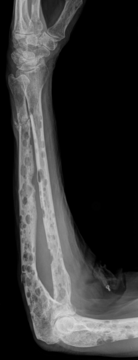Multiple Myeloma
Multiple myeloma (MM), also known as plasma cell myeloma, is a cancer of plasma cells that produces abnormal antibodies. These cells accumulate in the bone marrow, causing various systemic manifestations.
Signs and Symptoms
Multiple myeloma can affect many organs, resulting in a wide range of symptoms. The most common initial symptoms are fatigue and bone pain, particularly in the spine and ribs. The CRAB criteria (Calcium elevation, Renal insufficiency, Anaemia, and Bone lesions) are used to diagnose active multiple myeloma. Elevated calcium levels, reduced kidney function, low haemoglobin, and bone lesions visible on imaging are indicative of the disease.

Bone pain is reported in about 70% of cases and is often aggravated by movement. Pathological fractures and vertebral involvement, leading to spinal cord compression or kyphosis, are also common. Anaemia in multiple myeloma is typically normocytic and normochromic, resulting from bone marrow infiltration by tumour cells. Impaired kidney function can arise from the deposition of abnormal proteins produced by malignant cells, which may lead to acute or chronic kidney failure. Infection risk is elevated due to compromised immune function, leading to frequent pneumonias, urinary tract infections, and sepsis.
Diagnosis
Blood Tests
Diagnostic evaluation includes blood tests for paraproteins, often revealed by serum protein electrophoresis. The presence of a monoclonal protein, such as Bence Jones protein in the urine, is a key diagnostic indicator.

Histopathology
Bone marrow biopsy is essential to estimate plasma cell infiltration. Immunohistochemistry and flow cytometry can determine the clonality of plasma cells.

Medical Imaging
A skeletal survey using X-rays, CT scans, or MRIs can reveal characteristic lytic lesions in bones.


Treatment
Multiple myeloma is considered treatable but not curable. Treatment aims to manage symptoms and prolong life.
Chemotherapy
Initial treatment for those under 65 often involves high-dose chemotherapy followed by autologous stem cell transplant (ASCT). For older patients, regimens like bortezomib, melphalan, and prednisone may be used. Maintenance therapy with drugs like lenalidomide can prolong remission.
Stem Cell Transplant
ASCT is preferred for eligible patients, while allogeneic stem cell transplantation is less common due to higher associated risks.
Newer Therapies
Recent advances include CAR-T cell therapy and bispecific T-cell engagers (BITE), which have shown promise in treating refractory cases. Examples include idecabtagene vicleucel and teclistamab.
Prognosis
The median survival for multiple myeloma patients has improved with advancements in treatment, with a 5-year survival rate around 54% in the U.S. Prognostic factors include genetic abnormalities and response to initial treatment.

Conclusion
Multiple myeloma is a complex and multifaceted disease requiring a multidisciplinary approach for diagnosis and treatment. Ongoing research and new therapies continue to improve patient outcomes.
Self-assessment MCQs (single best answer)
What is the primary cell type involved in multiple myeloma?
Which of the following is NOT part of the CRAB criteria used to diagnose active multiple myeloma?
What is a common initial symptom of multiple myeloma?
Which diagnostic test is used to detect paraproteins in multiple myeloma patients?
What is the purpose of a bone marrow biopsy in diagnosing multiple myeloma?
What kind of lesions are typically revealed on a skeletal survey in a patient with multiple myeloma?
Which treatment is often used for multiple myeloma patients under the age of 65?
Which of the following is a newer therapy showing promise in treating refractory multiple myeloma?
What is the 5-year survival rate for multiple myeloma patients in the U.S. as mentioned in the text?
Which of the following conditions can result from impaired kidney function in multiple myeloma patients?
Dentaljuce
Dentaljuce provides Enhanced Continuing Professional Development (CPD) with GDC-approved Certificates for dental professionals worldwide.
Founded in 2009 by the award-winning Masters team from the School of Dentistry at the University of Birmingham, Dentaljuce has established itself as the leading platform for online CPD.
With over 100 high-quality online courses available for a single annual membership fee, Dentaljuce offers comprehensive e-learning designed for busy dental professionals.
The courses cover a complete range of topics, from clinical skills to patient communication, and are suitable for dentists, nurses, hygienists, therapists, students, and practice managers.
Dentaljuce features Dr. Aiden, a dentally trained AI-powered personal tutor available 24/7 to assist with queries and provide guidance through complex topics, enhancing the learning experience.
Check out our range of courses, or sign up now!


